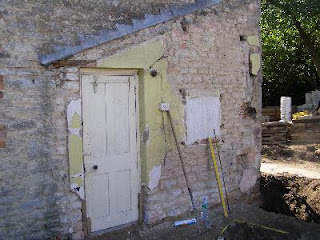When we did the extension last November, we had replaced the lintel above this kitchen door as we found that the old one had rotted at one end, thanks to the poor flashing on the old extension roof. This photo shows the door (before it was turned round) after the demolition of the old extension, and the rotten lintel is clearly visible.
 This
rot was a shame as the lintel was made of three bits (to give 16 inches wall
thickness) of four inch pitch pine which still smelt wonderful. This
unexpected work meant that some of the plaster already done inside was
removed, and then the rest of the plaster around the door became
loosened when the door frame was done. So, it was back to stripping
plaster on Thursday, followed by some more lime plastering for the scratch coat on Friday.
This
rot was a shame as the lintel was made of three bits (to give 16 inches wall
thickness) of four inch pitch pine which still smelt wonderful. This
unexpected work meant that some of the plaster already done inside was
removed, and then the rest of the plaster around the door became
loosened when the door frame was done. So, it was back to stripping
plaster on Thursday, followed by some more lime plastering for the scratch coat on Friday. We have a lot of old doors in the house, most of which were covered in a sort of brown varnish which clogs sandpaper very easily. At first I didn't like them as I thought they were probably the 1920s version of those horrible cheap panelled white things you get in all new houses and refurbishments these days. That's probably a bit unfair as, despite the varnish, I've come to appreciate them - an example of why you should never make changes in a rush on an old house unless absolutely essential. They have four panels with the upper pair being larger than the lower ones; most have a simple right angle recess, but in the lounge and the hall side of the kitchen door they have a bit of ogee architrave (which of course makes stripping more difficult!). These doors are also different sizes - I discovered this last November when I thought about changing the hinge side of the kitchen to extension door, and measured them all to see if I could swap them around. "Never assume - check" was the flight safety mantra when I was in the RAF, and it's true for old houses as well.
Since the door frame was being completely replaced, it seemed sensible to turn the door round, rather than cut new hinge recesses etc. However, the horrible rough white-ish finish now on the kitchen side meant that I knew I would have to do some serious stripping and restoration before too long, as it just looked so bad every time you went in the kitchen. Mind you, the side on the extension was brown paint and didn't look much better.
Anyway, just after Easter I decided that now was the time and I've done the complete thing over the last two weeks (i.e. slowly). The old paint was ghastly and probably toxic, so when I used the heat gun and a scraper, I made sure there was plenty of ventilation. It was possibly half a millimetre thick in places and came off as a nasty goo on the scraper which itself had to be scraped off before the next go. After that the rest was a doddle and yesterday I applied the final coat (see photo left) which is always the best bit - it's so satisfying, as opposed to the scraping, sanding, filling, priming and undercoat which are all just boring
The result is that it all looks much better and Jane loves it, even though I have yet to finish the remaining coats of plaster.





